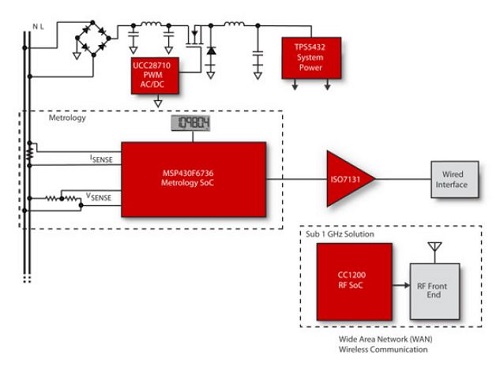TI's PowerLab Reference Design Library supplies over 1,000 fully tested power reference designs for E-Meters and other applications. The library is free and includes all supporting documentation such as circuit schematics, test results, printed circuit boards, bills of material, Gerber files, and the associated power management products; it is an invaluable resource in hands any Smart Grid technology designer.
Design value
Designing a future-proof smart meter, grid infrastructure, and home or building automation solution requires the broadest Smart Grid portfolio of metrology expertise, application processors, connectivity systems, RFID and analog. In this regard, reference designs from reputable sources are monumentally beneficial. TI has shipped millions of energy-meter ICs over the past decade and is an expert in innovative, secure, and economical semiconductor solutions for Smart Grid implementation. Leveraging TI's PowerLab reference design library allows users to identify a working E-Meter power solution that matches their unique design requirements and saves time to market.
Examples include these E-Meter Power Reference Designs:
o 85VAC to 305VAC input 3.7V/2A flyback
o 3-phase e-meter design with PLC on board
o 85VAC to 265VAC input, 15V/1A output, green-mode flyback
o Quasi-resonant flyback converter for high-input voltage (up to 415VAC)
o 100VDC to 650VDC input 12V/ 40W isolated flyback
o 200VAC to 400VAC input, 12V/3W quasi-resonant flyback
o Primary-side regulated flyback with 85VAC to 265VAC input
o 85VAC to 265VAC input 3.3V/10V 15W flyback
o 120VAC input, 3.3V/1.2A output, non-isolated flyback
Smart electricity meter pervasion
The proliferation of advanced metering infrastructure and automatic meter reading, key aspects of a smart energy system, is dependent on additional benefits beyond a reduction in meter-reading costs. Instead, optimization for asset tracking, dynamic pricing, tamper notification, outage management, supply automation, load profiling, and network diagnostics must develop in tandem with AMR and AMI to justify its cost-to-benefits analysis. Since these elements are compelled by cost, existing infrastructure, and local regulation, it is imperative that system designers select the most optimal and flexible power reference design that fulfills their nation's specific requirements.
The overall smart-metering system is driven away from mechanical meters and toward static electronic meters for all major utilities: electricity, gas, water and heat. An entire implementation may include power line communication to the electricity meter as well as low power wireless communication from the electricity meter to the other utility meters, either through Bluetooth Low Energy or ZigBee.

PowerLab can be used to obtain reference designs for all the components in TI’s cost-optimized e-meter Smart Grid solution
Using PowerLab
PowerLab's reference design selection tool enables searching across multiple subcategories such as input or output operating range, application type, topology, or even part number. This quickly narrows down the list of potential solutions to the exact fit.
Every subtopology in each category is automatically selected when performing a search, so one must specifically select e-meters, or whatever application solution they are searching under. This action reduces the search results from over 1,000 down to a more manageable list of designs. The final results can be then exported into Microsoft Excel for additional organization and analysis.

Orderable part numbers, in stock at Mouser:
• TPS2511
• LM3466
• UCC28700
• TPS40210
• TPS2540

• Discover TI's PowerLab Reference Design Library
• Learn more about TI e-meter solutions
• See this cost-optimized e-meter solution
Advertisement
Learn more about Texas Instruments





